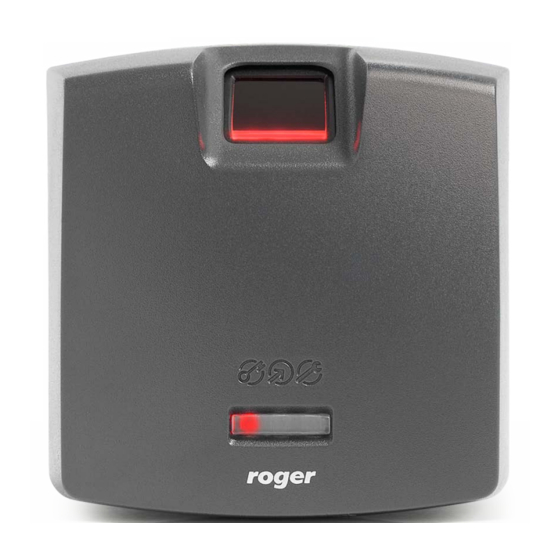
Roger RFT1000 Integration Manual
Access control system
Hide thumbs
Also See for RFT1000:
- User manual (20 pages) ,
- Quick start manual (2 pages) ,
- User manual (13 pages)
Summary of Contents for Roger RFT1000
- Page 1 Roger Access Control System RFT1000 Integration Manual Firmware version: 1.1 or newer Hardware version: 1.0 Document version: rev. A...
-
Page 2: Table Of Contents
Contents 1. Introduction ......................... 3 1.1 This manual ........................3 2. Description and specification ..................3 3. Installation ........................4 3.1 Terminals and connection diagrams ................... 4 3.2 LED indicators ........................6 3.3 Power supply ........................6 3.4 Inputs ..........................6 3.5 Use/installation guidelines .................... -
Page 3: Introduction
RFT1000 fingerprint readers by means of RogerVDM software. The purpose of the present manual is to describe use of RFT1000 readers beyond RACS 4 system in any third party application requiring user identification by means of fingerprints and/or Mifare proximity card. Whereas use of RFT1000 readers in RACS 4 system made by Roger is described in the document RFT1000 User Manual, which is available at www.roger.pl. -
Page 4: Installation
3. I NSTALLATION 3.1 Terminals and connection diagrams Fig. 1 RFT1000 terminals Table 2. RFT1000 terminals Terminal Description Positive power supply contact, 12VDC Negative power supply contact and reference potential for RS485 communication bus and input lines Tamper switch, 24V/50mA... - Page 5 Fig. 2 Connection diagram for RFT1000 and master device (controller) - configuration through Ethernet port (recommended) Fig. 3 Connection diagram for RFT1000 and master device (controller) - configuration through RS485 port Page 5 of 16...
-
Page 6: Led Indicators
Input lines can be configured by means of RogerVDM software so they could be used for activation of LED indicators and/or buzzer in RFT1000 as well as for switching card reader mode. More information on configuration of inputs is given in section 4.3 Configuration of inputs and LED indicators. -
Page 7: Configuration
· In case of connection through Ethernet port, twisted pair cable should be unisolated in the shortest possible distance and wires should remain twisted in the longest possible distance. · RFT1000 can be mounted to the wall be means of screws on standard flush mounting box (Ø 65 mm). - Page 8 is not blocked. Default IP address of the reader is 192.168.0.70 and port is 13544, while communication passwords is empty. 6. Select Connect button. Fig. 4 Connection window in RogerVDM software After establishing the connection it is possible to modify communication parameters both for Ethernet and RS485 communication.
-
Page 9: Wiegand Interface
Fig. 5 Configuration window in RogerVDM software 4.2 Wiegand interface RFT1000 reader can operate with all kinds of master devices if they are equipped with Wiegand interface. After proper connection in accordance with fig. 2, there must be executed configuration of connection both on RFT1000 side and master device side. - Page 10 More information on recognition mode is given in section 4.4 Recognition modes In case of 1:N recognition mode: · when the input is activated then RFT1000 both scans fingerprints and reads proximity cards · when the input is deactivated then RFT1000...
-
Page 11: Recognition Modes
Configuration in RogerVDM software (see fig. 5). 4.4.1 Mode 1:N In 1:N mode, list of users is recorded in RFT1000 memory. Each user should have his ID number, card number, and 1 to 10 fingerprint templates. The identification of user in 1:N mode consists in reading his fingerprint or card number by RFT1000. -
Page 12: User Identification
After activation of Master authorization option, users with such attribute are not obliged to scan their fingerprints for all RFT1000 readers with Accept authorization master option in General settings area (see fig. 5) activated. For such user, card number is sufficient for is identification. -
Page 13: Card Code
Fig. 6 User enrolment window in RogerVDM software Fig. 7 Card programming window in RogerVDM software 4.6 Card code Mifare Classic and Mifare Ultralight cards have their read-only serial numbers called CSN and memory, where administrator defined number called SSN can be stored. Optional SSN code provides additional security as it can be saved in administrator defined sector and it can be protected with access code against unauthorized reading. -
Page 14: Ssn Code Programming
Default settings of RFT1000 reader in Card code area is as follows: CSN code length = 7, SSN code length = 0. In case of such settings, the RFT1000 reads 7 bytes of CSN code only. In case of exemplary settings: CSN code length = 4, SSN code length = 4, RFT1000 reader during card identification would read code consisting of 4 bytes of CSN code and 4 bytes of SSN code. -
Page 15: Firmware Update
1. Select the option Tools in the top menu of RogerVDM software and then select Update firmware 2. In the newly opened window select RFT1000 firmware file (*.frg extension) by means of the button Select file 3. Select the button Update in order to upload the firmware to RFT1000 RFT1000 keeps all its settings (including IP address) after firmware update. -
Page 16: Product History
Weight of the equipment is specified in the document. Contact: Roger sp.j. 82-400 Sztum Gościszewo 59 Tel.: +48 55 272 0132 Fax: +48 55 272 0133 Tech.














Need help?
Do you have a question about the RFT1000 and is the answer not in the manual?
Questions and answers